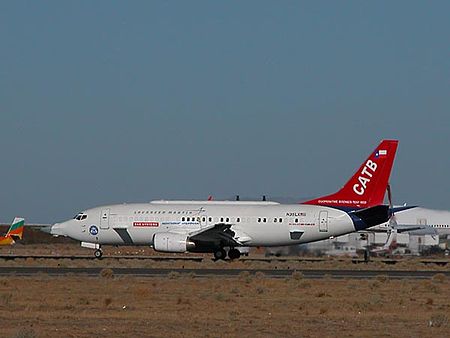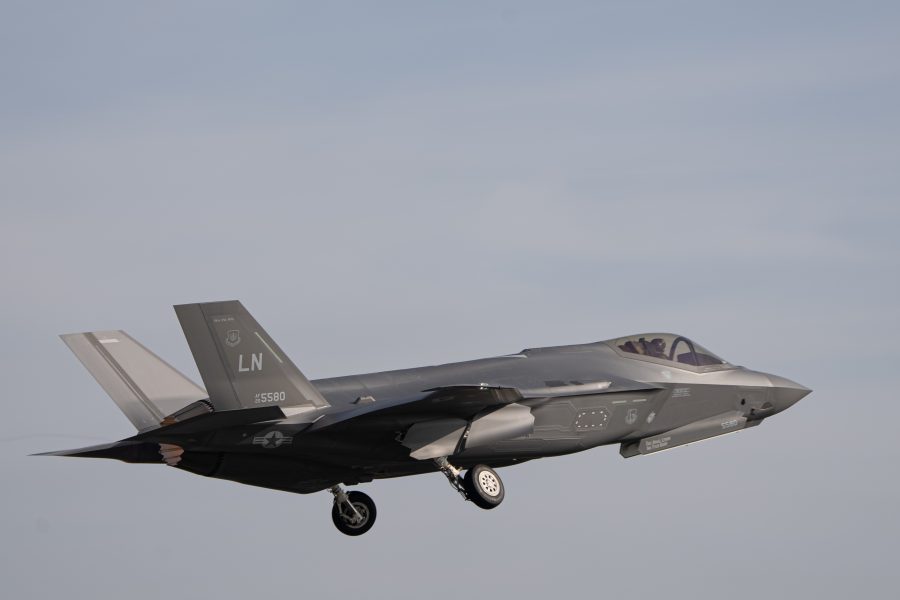Exasperated with the delays to the F-35’s Tech Refresh 3 update—which has held up deliveries of completed fighters since last fall—the House Armed Services Committee wants to slash the military services’ fiscal 2025 F-35 purchase by at least 10 aircraft and as much as 20.
The “chairman’s mark” of the 2025 National Defense Authorization Act, signed by Rep. Mike Rogers (R-Ala.), yanks $1 billion from F-35 procurement, shifting about $850 million to cover the cost of adding another Cooperative Avionics Test Bed aircraft, making a “digital twin” of the F-35, and setting up another Mission Software Integration Laboratory. It also directs Defense Secretary Lloyd Austin to implement a series of “corrective actions” on the program.
A staffer for a HASC airland subcommittee member told Air & Space Forces Magazine that “we are trying to get the attention” of the Pentagon and F-35 maker Lockheed Martin, “that we are tired of talking about [F-35 delays] and hearing excuses. … Once and for all, let’s get this thing straightened out.” He said the committee backs the F-35, but as the TR-3 is the basis “for everything to come, we need to get this on a solid basis now.”
The Air Force, Marine Corps, and Navy requested 68 F-35s in the fiscal 2025 budget, asking for 42, 13, and 13 of the fighters, respectively. The draft NDAA will slice at least 10 aircraft from that collective buy, to 58 total aircraft—36 F-35As, 11 F-35Bs, and 11 F-35Cs among the services, respectively.
If the Secretary of Defense and the Joint Program Office make a series of corrective actions in the program that satisfy the committee, they can avoid cuts of yet another 10 aircraft. If not, there will be a further reduction to just 48 F-35s in total, leaving the Air Force, Marine Corps and Navy with 30, 9, and 9 F-35s, respectively.
F-35 Procurement for 2025
| Aircraft | 2025 Budget Request | House NDAA with Corrective Actions | Without Corrective Actions |
|---|---|---|---|
| F-35A | 42 | 36 | 30 |
| F-35B | 13 | 11 | 9 |
| F-35C | 13 | 11 | 9 |
| TOTAL | 68 | 58 | 48 |
The Program Executive Officer for the F-35, Air Force Lt. Gen. Michael J. Schmidt, has testified in recent weeks that the pace of TR-3 testing has been slowed by insufficient test assets and numbers of programmers. Because testing is incomplete, aircraft manufactured with the TR-3 hardware/software package can’t be delivered and have been parked immediately after coming off the production line. An estimated 75 aircraft are completed and in storage at an undisclosed facility, awaiting delivery.
Schmidt has also said the Block 4 upgrade—for which the TR-3 is the basis—is being “reimagined,” with a new timeline that would defer many Block 4 capabilities to the 2030s.
Completion of TR-3 testing is now a year late, and Schmidt has testified that even a “truncated” version of the software—something less than the full TR-3—won’t be available until the third quarter of this year. Schmidt told Congress the F-35’s international partners have agreed to the truncated version of the package in order to get deliveries moving again, but government sources said a decision to do so has still not been made. One said the JPO is waiting “until the software is stable.”
Lockheed Martin chairman Jim Taiclet told financial reporters in April that the truncated version would allow pilots to practice using systems that won’t be fully operational until the all-up TR-3 comes long. He called it a “combat-capable training” version of the software. He also said only 75-110 F-35s out of a planned 156 will be delivered in 2024, although annual deliveries typically vary from the production figure.
Schmidt has said the fully completed TR-3 won’t arrive before 2025.
The delays have meant that U.S. and foreign F-35 customers have not been able to make a timely transition from previous fighters to the new ones.
A spokesperson for the F-35 Joint Program Office said “we are reviewing the chairman’s mark and look forward to working with Congress to keep the F-35 program ready to address national defense requirements.”
A spokesperson for Lockheed Martin said “we look forward to working with the Administration and Congress as the President’s fiscal year 2025 budget receives full consideration in the months ahead.”
The draft NDAA directs Defense Secretary Lloyd Austin to create and submit a new acquisition strategy for the F-35, “with appropriate actions and milestones,” as well as a “digital twin” of the aircraft and its mission systems. A digital twin is a full digital model of the aircraft with all elements, down to the fasteners. These models are typically used to refine designs and facilitate upgrades.

Austin is also to present an acquisition strategy to procure “at least one new Cooperative Avionics Test Bed aircraft for the F-35 enterprise.” There is one such 737-based “CATbird” now, which is government owned/contractor-operated, used to test radars, avionics, and other equipment for the F-35.
The Defense Secretary is furthermore to present a strategy to set up a new F-35 mission software integration laboratory (SIL) “to enable concurrent testing of TR–2 and TR–3 mission system hardware, software, and any existing or new F–35 capabilities.”
Neither a new CATbird nor a new SIL can be procured and built quickly. The CATbird is an extensively modified, bespoke aircraft, bearing an F-35 nosecone and wing elements and extensive evaluation gear. The original aircraft took over a year to modify. A new SIL will require a building and software engineers to fill it, at a time when the defense industry generally has complained about being able to hire programmers.
The HASC earmarked $200 million for the new CATbird, $350 million to create the digital twins, and $300 million for the SIL.
The committee also directed Austin to “implement a plan of corrective actions and milestones to resolve all deficiencies and recommendations” contained in the Pentagon’s Director of Operational Test and Evaluation annual report to Congress. Among these were an insufficient number of test aircraft, cyber testing, integrating the F-35 with the Joint Simulation Environment, and logistics systems.
The committee additionally wants a corrective action plan from Austin that will “minimize F-35 new aircraft production interruptions and resolve all programmatic deficiencies” with its APG-85 radar hardware and software. Austin is to put into effect corrective actions recommended by the F-35 software Independent Review Team commissioned by Schmidt and Air Force Secretary Frank Kendall.
